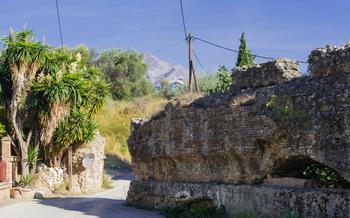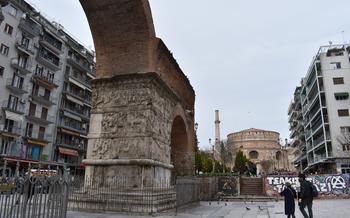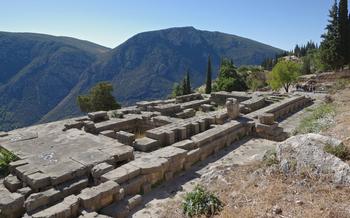
The Roman Aqueduct at Moria
- History of the Roman Aqueduct at Moria: A Testament to Roman Engineering
- Location and Accessibility
- Architectural Features
- Water Supply System
- Restoration and Preservation
- Surrounding Area
- Local Legends and Folklore
- Photography Opportunities
- Historical Context
- Guided Tours
- Accessibility for People with Disabilities
- Nearby Accommodation
- Visitor Information
- Responsible Tourism
- Insider Tip:
History of the Roman Aqueduct at Moria: A Testament to Roman Engineering
In the heart of Mytilene, on the picturesque island of Lesvos, stands the Roman Aqueduct at Moria, a testament to the ingenuity and engineering prowess of the ancient Romans. Constructed in the 2nd century AD, this remarkable structure served as a vital water supply system, transporting water from distant springs to the city's growing population.
The aqueduct's construction involved meticulous precision and a deep understanding of hydraulic engineering. Skilled craftsmen used locally sourced limestone and volcanic rock, carefully chiseling and shaping each block to create the aqueduct's imposing arches and vaulted ceilings. These arches, a hallmark of Roman architecture, not only provided structural stability but also allowed for efficient water flow, ensuring a steady supply to the city's households and public fountains.
The aqueduct's design showcased unique architectural features, including strategically placed vents to regulate water pressure and prevent blockages. Its impressive dimensions, stretching over several kilometers, reflected the scale and ambition of the Roman Empire, which sought to bring the benefits of urban infrastructure to its far-flung territories.
The aqueduct played a crucial role in the development of Mytilene, transforming it into a thriving commercial and cultural center. The reliable supply of fresh water supported the city's growing population, enabling expansion and prosperity. The aqueduct's legacy endures as a symbol of the enduring influence of Roman engineering, a testament to their commitment to infrastructure and urban development.
Location and Accessibility
The Roman Aqueduct of Moria is a testament to ancient engineering and a fascinating attraction for visitors to Mytilene. Located just a short distance from the city center, it can be easily reached by public transportation or private vehicle.
To get there by public transportation, take the bus from the main bus station in Mytilene to the village of Moria. The aqueduct is a short walk from the bus stop. If driving, follow the signs to Moria from the main road leading out of the city. Ample parking is available near the aqueduct.
The best time to visit the aqueduct is in the morning or late afternoon when the lighting is optimal for photography and there are fewer crowds. It's also worth considering visiting during the spring or fall when the weather is mild and pleasant.
Architectural Features
The Roman Aqueduct at Moria stands as a testament to the remarkable engineering prowess of the ancient Romans. Its towering arches, stretching towards the sky, create a majestic spectacle. The vaulted ceilings, supported by sturdy pillars, add to the grandeur of the structure. The aqueduct's unique design incorporates intricate decorative motifs, showcasing the artistic sensibilities of its creators. The well-preserved state of the aqueduct is a testament to the high-quality construction materials used and the enduring nature of Roman engineering. Despite the passage of time and the elements, the aqueduct remains a sturdy and impressive monument to human ingenuity.
Water Supply System
The Roman Aqueduct at Moria served as a vital water supply system for the city of Mytilene. It ingeniously harnessed the natural resources of the surrounding hills to provide a steady flow of fresh water to the city's inhabitants. The aqueduct's source was a natural spring located in the hills above Moria. The water was channeled into an intricate network of underground pipes and conduits, carefully designed to maintain a consistent flow and prevent contamination. These channels were expertly constructed using a combination of stone, clay, and mortar, ensuring their durability and longevity. The aqueduct's channels meandered through the hills, following the natural contours of the land. This ingenious system allowed the water to flow by gravity, eliminating the need for pumps or other mechanical devices. The aqueduct's channels converged at the base of the hill, where the water was distributed to various parts of the city through a network of smaller pipes and fountains. This remarkable water supply system played a crucial role in the daily lives of Mytilene's residents, providing them with a reliable source of fresh water for drinking, bathing, and irrigation.
Restoration and Preservation
The Roman Aqueduct at Moria has undergone meticulous restoration and preservation efforts to ensure its longevity and continued existence. Recognizing its immense historical significance, local authorities and cultural heritage organizations have dedicated resources to maintain and protect this iconic structure.
Over the years, the aqueduct has faced the inevitable challenges of time and natural elements. Its stone arches and vaulted ceilings required careful repair and reinforcement to address structural weaknesses. Skilled artisans employed traditional techniques to restore the integrity of the aqueduct, preserving its original design and materials.
The restoration process involved meticulous cleaning and removal of vegetation that had accumulated over time. This delicate work helped expose the original features of the aqueduct, revealing intricate carvings and decorative elements that had been hidden for centuries.
Preserving the Roman Aqueduct at Moria is a testament to the importance of cultural heritage and the enduring legacy of ancient civilizations. Through these restoration efforts, future generations can continue to admire and appreciate this remarkable feat of Roman engineering.
Surrounding Area
The Roman Aqueduct at Moria is set against a backdrop of stunning natural beauty. The surrounding area is a haven for nature lovers, with lush greenery, rolling hills, and breathtaking views. Visitors can enjoy a leisurely stroll around the aqueduct, taking in the tranquil atmosphere and the scenic vistas. The aqueduct's location offers a unique opportunity to combine history with nature, creating a memorable and enriching experience.
In the vicinity of the aqueduct, visitors can explore other nearby attractions that showcase the rich history and culture of Mytilene. The picturesque village of Moria, with its charming streets and traditional houses, is worth a visit. The village is home to several churches, including the Church of the Assumption, which is adorned with beautiful Byzantine frescoes.
For those seeking a more active experience, the area surrounding the aqueduct offers numerous hiking trails and cycling paths. The trails wind through forests, meadows, and along the coast, providing stunning views of the surrounding landscape. Visitors can choose from various trails, ranging from easy walks to more challenging hikes, catering to all fitness levels.
After a day of exploration, visitors can relax and unwind at one of the nearby tavernas or cafes. These establishments offer a taste of traditional Greek cuisine, using fresh local ingredients to create delicious dishes. Visitors can savor the flavors of Greece while enjoying the warm hospitality of the local people.
Local Legends and Folklore
The Roman Aqueduct at Moria is steeped in local legends and folklore that have been passed down through generations. One enchanting tale tells of a beautiful water nymph named Myrina who resided in the aqueduct's depths. Legend has it that she would emerge from the water at night, captivating passersby with her enchanting songs and dances. Locals believed that those who listened to her melodies would be blessed with good fortune and happiness.
Another captivating legend recounts the story of a brave young shepherd named Alexis who discovered a hidden treasure within the aqueduct's walls. Guided by a mysterious dream, Alexis ventured into the depths of the aqueduct and found a secret chamber filled with gold and jewels. With his newfound wealth, he returned to his village and shared his fortune with those in need, becoming a symbol of generosity and prosperity.
These legends and stories add a touch of magic and intrigue to the Roman Aqueduct at Moria, connecting it to the rich cultural heritage of Mytilene. They serve as a reminder of the importance of preserving local traditions and folklore, which are an integral part of the community's identity and sense of place.
Photography Opportunities
The Roman Aqueduct at Moria presents a myriad of captivating photo opportunities for enthusiasts and casual photographers alike. The towering arches, intricate vaulted ceilings, and weathered stone facade offer a picturesque backdrop for capturing stunning images. To fully capture the grandeur of the aqueduct, consider using a wide-angle lens that will allow you to encompass its entirety. For optimal lighting conditions, plan your visit during the golden hours of sunrise or sunset, when the warm hues cast a magical glow upon the ancient structure. A sturdy tripod will ensure stable and sharp photographs, allowing you to capture every detail of this architectural marvel.
Historical Context
The Roman Aqueduct at Moria stands as a testament to the enduring legacy of the Roman Empire in Mytilene. Constructed during the Roman period, which spanned from the 1st century BC to the 4th century AD, the aqueduct played a crucial role in the development and prosperity of the city. The Romans, renowned for their engineering prowess, left an indelible mark on Mytilene's infrastructure, transforming it into a thriving urban center. Their advanced knowledge of hydraulics and construction techniques enabled them to build an intricate water supply system that brought fresh water from distant sources to the heart of the city, demonstrating their commitment to public health and sanitation. The aqueduct stands as a symbol of Roman ingenuity and the lasting impact of their rule on Mytilene's cultural and historical landscape.
Other Roman ruins and landmarks in the area include the Roman Theater, located in the heart of Mytilene, which hosted theatrical performances and public gatherings. The Agora, or marketplace, was a bustling center of commerce and social interaction during Roman times. These remnants of the past offer a glimpse into the vibrant and cosmopolitan nature of Mytilene under Roman rule, showcasing the city's significance as a major port and trading hub in the ancient Mediterranean world. Understanding the historical context in which the aqueduct was built enriches the visitor's experience, allowing them to appreciate the aqueduct not only as an architectural marvel but also as a tangible link to Mytilene's rich and storied past.
Guided Tours
For a more immersive and educational experience, consider booking a guided tour of the Roman Aqueduct at Moria. Knowledgeable guides will lead you through the site, sharing fascinating insights into its history, engineering, and cultural significance. They can point out hidden details and answer any questions you may have.
Guided tours are available in various languages and often include additional stops at other nearby attractions, such as the Mytilene Castle or the Archaeological Museum of Mytilene. Group tours are suitable for budget-conscious travelers, while private tours offer a more personalized experience.
To ensure a spot, especially during the peak tourist season, it's advisable to book your tour in advance. Contact the local tourism office or check online for tour operators and availability.
Accessibility for People with Disabilities
The Roman Aqueduct at Moria is committed to accessibility for visitors of all abilities. The site features ramps and accessible pathways that allow wheelchair users and visitors with limited mobility to explore the aqueduct's grounds and admire its architectural grandeur. Visitors can easily navigate the site without encountering any obstacles or barriers. By making the aqueduct accessible, the local authorities ensure that everyone has the opportunity to appreciate and learn from this significant historical landmark. This inclusive approach encourages participation and fosters a sense of belonging for all visitors, regardless of their physical abilities.
Nearby Accommodation
For a convenient and immersive experience, consider staying in one of the charming hotels or guesthouses located within walking distance of the Roman Aqueduct at Moria. These accommodations offer a range of options to suit different budgets and preferences, ensuring a comfortable and memorable stay in Mytilene.
When choosing your accommodation, prioritize proximity to the aqueduct to make the most of your visit. Many hotels and guesthouses in the area offer stunning views of this iconic landmark, allowing you to wake up to its grandeur each morning.
Booking your accommodation in advance is highly recommended, especially during the peak tourist season, to secure a room with the desired amenities and location. Online booking platforms or contacting the establishments directly can help you find the perfect place to stay.
Visitor Information
For further assistance and information on the Roman Aqueduct at Moria, feel free to contact the local tourism office or visitor center. The friendly and knowledgeable staff will provide you with brochures, maps, and other resources to help you plan your visit. They can also provide up-to-date information on opening hours, admission fees, and any special events or exhibitions taking place at the aqueduct. By contacting the tourism office, you can ensure that you make the most of your visit and have a truly enriching experience.
Responsible Tourism
As you explore the Roman Aqueduct at Moria, it is essential to practice responsible tourism. Remember that this historic structure is a symbol of Mytilene's rich past and deserves to be treated with respect. Avoid littering, vandalism, or any actions that could damage the site. Instead, embrace sustainable tourism practices by minimizing your environmental impact. Respect the local culture and traditions, and contribute to the preservation of this magnificent heritage for future generations. Let's work together to ensure that the aqueduct continues to stand as a testament to the ingenuity and engineering prowess of the ancient Romans for many years to come.
Insider Tip:
For a unique souvenir to remember your visit to the Roman Aqueduct at Moria, head to the nearby Mytilene Central Market. Amidst the vibrant stalls, you'll find an array of handcrafted goods, including intricate ceramics, woven textiles, and delicious local delicacies. Indulge in the flavors of Mytilene with a taste of traditional sweets like "loukoumades" (honey-dipped doughnuts) or "xerotigana" (crunchy pastries). Don't miss the opportunity to mingle with the locals, who are always eager to share stories and recommendations about their beloved city.



